

Yijing Dao. The I Ching Basics. I Ching is an ancient, sophisticated fortune-telling tool used by the Chinese to predict the pattern of events which will govern and shape our destiny.
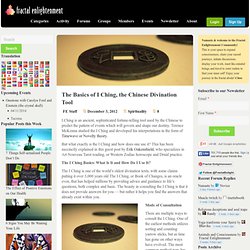
Terence McKenna studied the I Ching and developed his interpretations in the form of Timewave or Novelty theory. But what exactly is the I Ching and how does one use it? This has been succinctly explained in this guest post by Erik Oakenshield, who specializes in Art Nouveau Tarot reading, or Western Zodiac horoscope and Druid practice. The I Ching Basics: What Is It and How Do I Use It? The I Ching is one of the world’s oldest divination texts, with some claims putting it over 3,000 years old The I Ching, or Book of Changes, is an oracle even, that has helped millions by providing advice and guidance to life’s questions, both complex and basic.
The most common method to consult the I Ching is tossing the coin Mode of Consultation There are multiple ways to consult the I Ching. The Importance of Mental Focus. How to Throw the Coins to Obtain a Reading for the I Ching. How to Throw the Coins to Obtain a Reading for the I Ching The Chinese Book of Change – The I Ching (pronounced Yee Jing) – is one of the most ancient books in existence – some of it is 3000 years old.
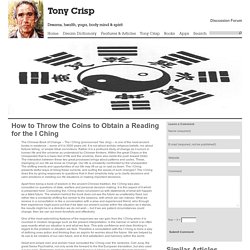
It is not about archaic religious beliefs, nor about fortune telling, or simple tribal convictions. Rather it is a profound study of change as it occurs in human life and the universe as understood by Chinese thinkers. Within the great Chaos or the Unexpected that is a basic fact of life and the universe, there also exists the push toward Order. The interaction between these two great processes brings about patterns and cycles. I Ching ♦ The Book of Changes. According to the original meaning, the attributes [sublimity, potentiality of success, power to further, perseverance] are paired. When an individual draws this oracle, it means that success will come to him from the primal depths of the universe and that everything depends upon his seeking his happiness and that of others in one way only, that is, by perseverance in what is right. The specific meanings of the four attributes became the subject of speculation at an early date.
The Chinese word here rendered by "sublime" means literally "head," "origin," "great. " This is why Confucius says in explaining it: “Great indeed is the generating power of the Creative; all beings owe their beginning to it. This power permeates all heaven.”3 For this attribute inheres in the other three as well. Map: Chan Dào (ZENTAO) - Yin Yang - Wu Xing - Yi Jing. Astrologie chinoise CHINASTRAL, Yi - King. Five Directions. Book of Changes. LiSe YiJing. Tout se transforme. Tableau des 64 hexagrammes du Yi King Liste des 64 hexagrammes du Yi King N.B. : Sont données successivement, séparées par des points, les traductions des hexagrammes proposées par plusieurs auteurs (Richard WILHELM, Wang Dongliang, Pierre Louis Félix PHILASTRE, Cyrile JAVARY).
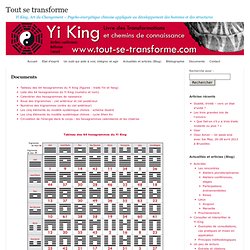
Source : Le Tao du Yi King, Jacques WARIN, éditions du Rocher, 2001. Hexagramme 1 : L’élan créatif. Le créateur. Pour connaître votre hexagramme de naissance Le tableau ci-dessous est un calendrier perpétuel. Le numéro de l’hexagramme n’est pas signifiant en soi. (d’après Les Secrets de l’astrologie du Yi King, Yves THIEFFRY, éd. Roue des trigrammes : ciel antérieur et ciel postérieur L’ordre dit du ciel antérieur est attribué au personnage mythique de Fu Xi, celui dit du ciel postérieur au roi Wen, à qui est attribuée la création de la plus grande partie des hexagrammes. Trigrammes. @Cieloevento. Les hexagrammes du Yi-King. Les hexagrammes du Yi-King Le terme "hexagramme" nous vient des traductions du XIXeme siècle (du Grec : hexa six, gramme lettre, écriture).
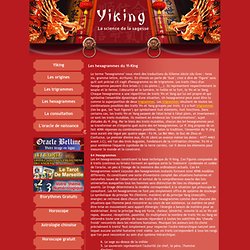
En chinois on parle de "Gua", c'est à dire de "figure" sans qu'il soit précisé s'il s'agit d'hexagramme ou de trigramme. Les traits (Yao) d'un hexagramme peuvent être brisés (--) ou pleins (__). Ils représentent respectivement le souple et le ferme, l'obscurité et la lumière, le faible et le fort, le Yin et le Yang. Chaque hexagramme a une répartition de traits Yin et Yang qui lui est propre et qui symbolise l'ensemble dynamique d'une situation. Yi King, le Livre des Mutations - Yi Jing. Ce dispositif de 64 hexagrammes et de leurs commentaires et transformations est à la source de la pensée chinoise.
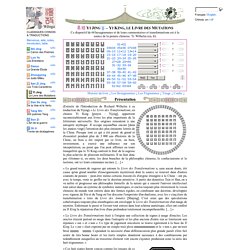
Tr. Wilhelm (en, fr). Histoire du livre ↓ Les Hexagrammes ↓ Les Trigrammes ↓ Tirage ↓ Confer ↓ Présentation. Le Yi-King - À propos des… - Qu'est-ce que le… - Interroger le… - Le blog de Maître Shi. Yi-King (yi jing en pinyin*) signifie "Classique de la Mue" que l'on traduit en Occident par Livre des Mutations ou Classique des Changements.
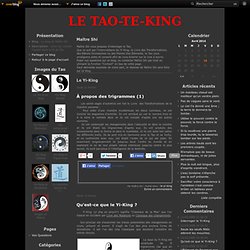
Son principe est d'examiner les traces potentielles des changements en cours, présent et avenir. Il s'agit de l'un des plus anciens livres de divinations. Il est l'un des cinq Classiques que devaient connaître les lettrés chinois. Yi King. I Ching. I Ching Hexagram Lookup. Yijing cards. Just a version... « Yi Blog. Yijing Research. Yijing Dao - Glossary of Chinese Yijing terms. This is a glossary of Yijing technical terms that appear on this site, in alphabetical order of pinyin syllables, so xiantian comes before xiangshu.
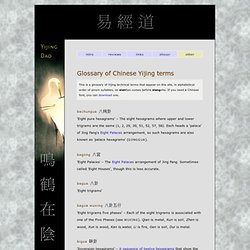
If you need a Chinese font, you can download one. bachungua 八純卦 'Eight pure hexagrams' – The eight hexagrams where upper and lower trigrams are the same (1, 2, 29, 30, 51, 52, 57, 58). The Image of the Cosmos in the Yijing. Le Yi Jing ne nous dit rien d'elle, il enclenche notre intuition. James DeKorne's Official Website - The Gnostic Book of Changes. Please select the chapter or hexagram below!
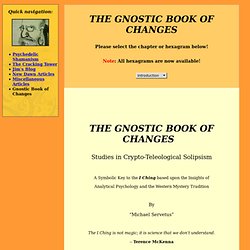
Note: All hexagrams are now available! Studies in Crypto-Teleological Solipsism A Symbolic Key to the I Ching based upon the Insights of Analytical Psychology and the Western Mystery Tradition By “Michael Servetus” The I Ching is not magic; it is science that we don’t understand. -- Terence McKenna The I Ching or Book of Changes is one of the world's most ancient manuscripts.
Although the original Chinese text has been in the public domain for more than three-thousand years, the present manuscript (the fruit of over thirty years of intense study) is currently un-publishable because most of the English translations and paraphrases (included herein solely for purposes of scholarly comparison) remain under copyright. The editor offers this, his personal study-guide, freely to those who wish to use and annotate it for their private, not-for-profit edification. Further annotations and commentary are encouraged. Terence McKenna - Time and the I-Ching.